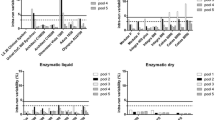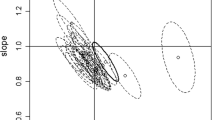Abstract
Background
Serum creatinine concentration is a primary component of Bedside Schwartz equation for estimated glomerular filtration rate (eGFR) in children. To standardize creatinine measurement, most manufacturers have adopted calibration procedures traceable to isotope dilution mass spectrometry (IDMS) using National Institute of Standards and Technology reference material. However, reference material representing much lower creatinine concentrations seen in children is not available and it is unclear how well commercial assays perform at pediatric levels.
Methods
One thousand nine hundred seventy-one specimens from consecutive children <19 years, with creatinine ≤0.8 mg/dL by Abbott Jaffe method were included. Creatinine measurements were compared between Abbott-Jaffe and Abbott-enzymatic methods. Furthermore, we evaluated performance of six commercial creatinine assays at concentrations seen in pediatric patients utilizing IDMS traceable serum samples.
Results
Median difference (enzymatic-Jaffe) for prepubertal females was –0.18 mg/dL (2.5%tile, 97.5%tile: –0.30, –0.06), –0.12 mg/dL (–0.25, –0.00) for pubertal females, –0.17 mg/dL (–0.30, –0.04) for prepubertal males, –0.11 mg/dL (–0.24, 0.01) for pubertal males. Bias appeared proportional for each subgroup and decreased as creatinine concentrations increased. Using IDMS traceable samples, the greatest inter-assay variability was seen with the lowest creatinine levels (target 0.273 mg/dL), where 67% (4/6) of methods failed to reach minimal bias specification of 8% (range –7.5 to 86%). For samples with higher creatinine targets (0.440–0.634 mg/dL), two methods failed to meet minimal bias specification, whereas four showed bias <8%.
Conclusion
Many commonly used creatinine assays remain inaccurate for pediatric populations after over a decade of nationwide efforts to standardize measurements. When creatinine-based eGFR is used for chronic kidney disease (CKD) staging in children, large inter-assay variability can lead to disease misclassification, inappropriate diagnostic and therapeutic interventions.
Graphical abstract
A higher resolution version of the Graphical abstract is available as Supplementary information




Similar content being viewed by others
References
Myers GL, Miller GW, Coresh J, Fleming J, Greenberg N, Greene T, Hostetter T, Levey AS, Panteghini M, Welch M, Eckfeldt JH (2006) Recommendations for improving serum creatinine measurement: a report from the Laboratory Working Group of the National Kidney Disease Education Program. Clin Chem 52:5–18
Mian AN, Schwartz GJ (2017) Measurement and estimation of glomerular filtration rate in children. Adv Chronic Kidney Dis 24:348–356
Hoste L, Deiteren K, Pottel H, Callewaert N, Martens F (2015) Routine serum creatinine measurements: how well do we perform? BMC Nephrol 16:21
Killeen AA, Ashwood ER, Ventura CB, Styer P (2013) Recent trends in performance and current state of creatinine assays. Arch Pathol Lab Med 137:496–502
Schwartz GJ, Kwong T, Erway B, Warady B, Sokoll L, Hellerstein S, Dharnidharka V, Furth S, Muñoz A (2009) Validation of creatinine assays utilizing HPLC and IDMS traceable standards in sera of children. Pediatr Nephrol 24:113–119
College of American Pathologists (2020) Chemistry/Therapeutic Drug Monitoring C-C 2020. Available from: https://www.cap.org/laboratory-improvement/proficiency-testing/e-lab-solutions-suite. Accessed 1 Apr 2021
Jassam N, Weykamp C, Thomas A, Secchiero S, Sciacovelli L, Plebani M, Thelen M, Cobbaert C, Perich C, Ricós C, Paula FA, Barth JH (2017) Post-standardization of routine creatinine assays: are they suitable for clinical applications. Ann Clin Biochem 54:386–394
Andersen TB, Erlandsen EJ, Frøkiaer J, Eskild-Jensen A, Brøchner-Mortensen J (2010) Comparison of within- and between-subject variation of serum cystatin C and serum creatinine in children aged 2–13 years. Scand J Clin Lab Invest 70:54–59
National Institute of Diabetes and Digestive and Kidney Diseases (2021) Bedside IDMS-traceable Schwartz GFR Calculator for Children. Available from: https://www.niddk.nih.gov/health-information/professionals/clinical-tools-patient-management/kidney-disease/laboratory-evaluation/glomerular-filtration-rate-calculators/children-conventional-units. Accessed 1 Apr 2021
Cobbaert CM, Baadenhuijsen H, Weykamp CW (2009) Prime time for enzymatic creatinine methods in pediatrics. Clin Chem 55:549–558
Greenberg N, Roberts WL, Bachmann LM, Wright EC, Dalton RN, Zakowski JJ, Miller WG (2012) Specificity characteristics of 7 commercial creatinine measurement procedures by enzymatic and Jaffe method principles. Clin Chem 58:391–401
Owen LJ, Keevil BG (2007) Does bilirubin cause interference in Roche creatinine methods? Clin Chem 53:370–371
Delanaye P, Cavalier E, Pottel H (2017) Serum Creatinine: Not So Simple! Nephron 136:302–308
Funding
The authors would like to thank Kelly Walewski and Robin Carey-Ballough from Beaumont Health at Royal Oak, and Angie Baldwin from the University of Chicago for their technical support.
Author information
Authors and Affiliations
Corresponding author
Ethics declarations
Ethics approval
The investigation was approved by the Institutional Review Board at Beaumont Health (#2021-178).
Competing interests
The authors declare no competing interests.
Additional information
Publisher's note
Springer Nature remains neutral with regard to jurisdictional claims in published maps and institutional affiliations.
Supplementary Information
Rights and permissions
About this article
Cite this article
Lao, K., Sykes, E., van Wijk, X.M.R. et al. Large inter-assay difference of serum creatinine in pediatric population: a threat to accurate staging of chronic kidney disease. Pediatr Nephrol 37, 677–681 (2022). https://doi.org/10.1007/s00467-021-05335-x
Received:
Revised:
Accepted:
Published:
Issue Date:
DOI: https://doi.org/10.1007/s00467-021-05335-x




